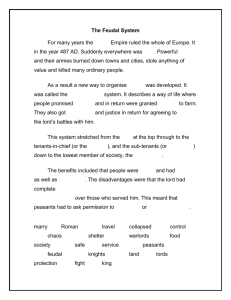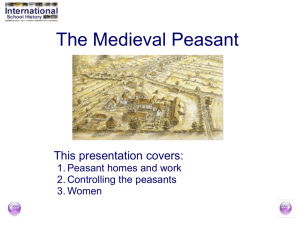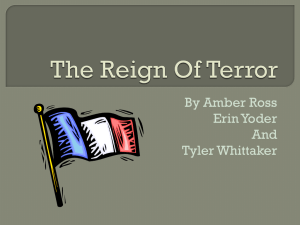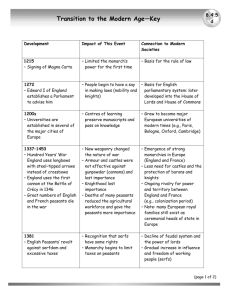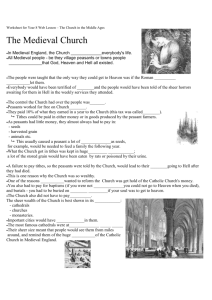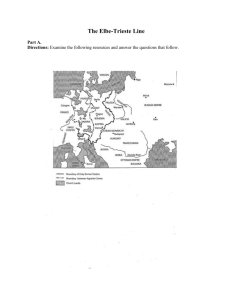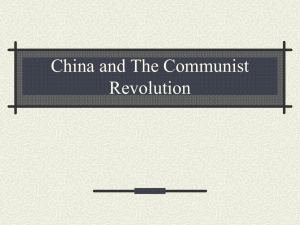2. In class simulation of how the land was divided before land reform
advertisement
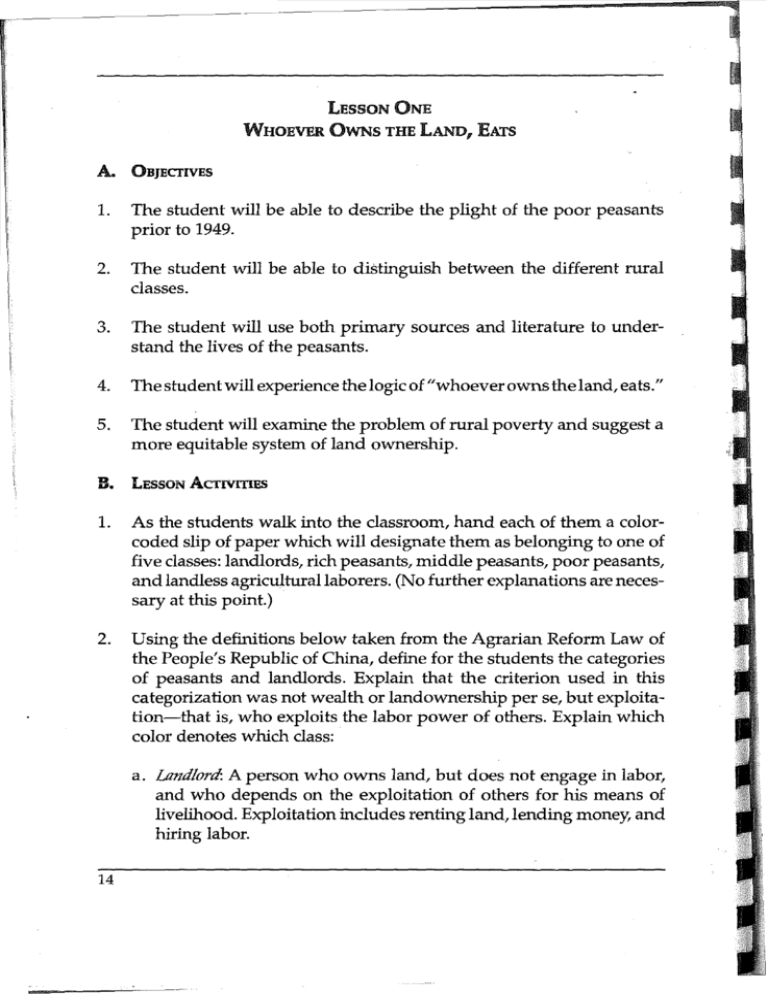
LESSON ONE WHOEVER OWNS THE LAND, EATS A. OBJECTIVES 1. The student will be able to describe the plight of the poor peasants prior to 1949. 2. The student will be able to distinguish between the different rural classes. 3. The student will use both primary sources and literature to understand the lives of the peasants. 4. The student will experience the logic of "whoever owns the land, eats." 5. The student will examine the problem of rural poverty and suggest a more equitable system of land ownership. B. LESSON ACTIVITIES 1. As the students walk into the classroom, hand each of them a colorcoded slip of paper which will designate them as belonging to one of five classes: landlords, rich peasants, middle peasants, poor peasants, and landless agricultural laborers. (No further explanations are necessary at this point.) 2. Using the definitions below taken from the Agrarian Reform Law of the People's Republic of China, define for the students the categories of peasants and landlords. Explain that the criterion used in this categorization was not wealth or landownership per se, but exploitation-that is, who exploits the labor power of others. Explain which color denotes which class: a. Landlord: A person who owns land, but does not engage in labor, and who depends on the exploitation of others for his means of livelihood. Exploitation includes renting land, lending money, and hiring labor. 14 • LSSSONONE b. Rich peasant. A person who generally owns all of his land, or owns part of his land and rents the rest from others. A rich peasant may exploit other peasants by hiring wage laborers, renting out land or lending money. Unlike a landlord, however, a rich peasant works some of the land himself. c. Middle peasant. A person who owns some land which he cultivates while the rest is rented, depends mainly on his own labor for a living, and does not exploit others. A middle peasant may be exploited by having to pay land rent or loan interest. d. Poorpeasant. Aperson who may own part of his land, but often owns none at all, and must rent land to cultivate. A poor peasant is exploited in terms of land rent, loan interest or having to sell his labor to landlords and rich peasants for periods of time. e. Landless agricultural laborers: A person who owns no land and who must sell her or his labor to others. , 3. Share Document A, The Ownership 0/ Land with students. Locate Zhejiang province and then explain that you will use it as the basis for dividing up landownership among the different classes. a. If there are 30 students in a class, 23 (77%) would be designated poor peasants, or landless hired laborers. Assuming that the desks represent land, they will "occupy" only 6 desks (20% of the land.) b. Five students (17%) would be designated as middle peasants, so they would occupy 6 desks (19% of the land.) c. One student (3%) will be a rich peasant and (s)he will occupy 2 desks (8% of the land). d. The one remaining student (3%) will be the landlord and will occupy 16 desks (53% of the land.) Since land is the basis of food production, whoever owns the most land. is going to be the best fed. Divide the food (candy) according to the number of desks to illustrate the point. 15 , LESSON ONE 4. To further dramatize the consequences of this inequity, 'read to students from Document S, a selection from William Hinton's Fanshen. Show students Shanxi (Shansi) on the map, where Long Bow Village IS. 5. In class, allow the students to discuss in their groups what changes, if any, should be made in the land ownership situation. 6. Discuss the following issues: a. Contrast the lives of landlords and rich peasants with that of poor and middle peasants. b. How does the selection about "crop watching" demonstrate the importance of the harvest? c. In what ways were poor peasants exploited by the rich peasants and landlords? 7. c. Either in class or as homework, ask each student to list up to five changes that should be made given his/her class perspective. At the beginning of the next class, have the students assemble in random groups and try to come up with a unified solution to the problem of unequal land ownership. This should prove difficult! ExTENDED ACTIVITIES 1. Use the selection from General Zhu De, "Exploitation of the Peasants" (Document C), as the basis for a diary entry that might have been written by a poor peasant. 2. Use the chart in Document A to draw three circle graphs showing land distribution in Shanxi (Shansi), Guangdong (Kwangtung), and Kiangsi (Jiangxi) provinces. Locate the three provinces on the map. 16 LESSON ONE D. VOCABULARY exploitation peasant landlord gentry cultivation millet maize Fanshen subsistence E. EVALUATING THE LESSON 1. Informal evaluation through class discussion, 2. Students will write a short paragraph (quickwrite) explaining and describing the condition of the peasant. 3. Use any of the "Extended Activities" listed above. 17 • • • •I I •I I • •I • •I I ~ I I I I LESSON Two EATING BITI'ERNESS, SPEAKING BI'ITERNESS: GAINING PEASANT SUPPORT FOR THE COMMUNIST REVOLUTION THROUGH LAND REFORM A. OBJECTIVES 1. To define revolution and tell why Mao Zedong felt it was necessary. 2. To define land reform and explain how it was achieved. 3. To be able to place land reform in the historical context of the struggle for power between the Communists and Nationalists. 4. To explain why Mao Zedong needed peasant support in order to defeat the Nationalist armies. 5. To appreciate the chaos that accompanied the process of land reform. B. LESSON ACTIVITIES 1. Students assemble in groups of 4--5 to compare their solutions to problems of peasant poverty. (If each student maintains a social class point of view, the solutions will differ.) Record the student generated options at this point, but make no value judgments. Hopefully the options will range from maintaining the status quo, to making some attempts at reform, and finally to making a complete land revolution. 2. Give the students the background information which puts the lesson in context. This can be done by either having students read the Background Materials (Document D), or by lecturing selectively from the information in the materials. Sample Questions for Discussion of Background. Materials a. What do you think is meant by the political slogan "land to the tiller"? b. Consider. How did the beliefs of Mao Zedong and Chiang Kai-shek differ? 25 LESSON Two c. What is a civil war? What two groups were fighting for control of China in the 1940s? d. Define land reform. Explain how Mao Zedong used this policy to gain support for his fight against the Nationalists. e. What do you think is meant by a "Kangaroo Court"? Would you like to be tried in this way? Why or why not? 3. Homework Assignment Share with students Document E. This historical resource illustrates the importance of the peasant in the Chinese Communist Party's struggle for supremacy over the Nationalist (Kuornintang) armies. a. Use your knowledge about Marxism to explain why the Communist Revolution had to be peasant-based. b. What is a revolution? When can it be justified, if ever? c. Explain how this marching song shows the tactics the Communists would use to win the peasants over to their side. 4. After the discussion, the students will be ready to read Document F, "Stone Village," a case study which dramatizes the difficulties the communist cadres faced in persuading frightened and intimidated peasants to overthrow despotic Landlord Wang. 5. Students might then debate whether land reform was pure, cruel robbery, or a necessity to prevent the landlord from continuing to exploit the peasants. a. Give the students 5-10 minutes to write down their position and reasons to support it. b. Ask for volunteers (2 from each side) to debate the issue in front of the class. c. After presentation of preliminary arguments and rebuttals allow the audience (class members) to ask the debaters to defend their positions. (Volunteers might be given this material the day before to allow for more preparation.) 26 I I I I I I I • • • • • •I • ~ .. LBSSONTwo 6. Return to the options discussed in Lesson Activity #1. Has anyone changed his/her mind? Why? Why not? c. Extended Activities L Research and explain: Did Chiang Kai-shek have a program to make the system of land holding more equitable? 2. Compare and contrast the American Civil War with the Chinese Civil War. Consider both the issues that were fought over as well as the outcome. 3. Use the information from Lessons One and Two to draw cartoons explaining "Eating Bitterness" and "Speaking Bitterness." 4. Read Document G, the Agrarian Reform Law of 1947 and explain in your own words how the Chinese Communist Party proposed to divide the land among the different classes of villagers. 5. Research how land reform has been used in at least one other region of the world. Assess the extent of its success. 6. Whatis a revolution? When mightit be justified? Give examples using any of the following: the American Revolution of 1776, the French Revolution of 1789, the Russian Revolution of 1917. D. Vocabulary imperialist tyrant gentry provocation rural liberated revolution piculs cadre tumult "we must overturn" kangaroo court -~ I 27 J LESSON Two E. Evaluating the Lesson 1. Informal evaluation through class discussion of essential understanding of the problem of inequity of land distribution and the range of solutions which existed. 2. Write a short speech to the poor peasants of a village urging them to overcome their fear and get rid of the landlords. 3. Write an editorial in which you react to this statement: "Given the conditions of the time, the practice of land reform was the only reasonable alternative and was essentially fair." 4. Write a short essay predicting whether Mao Zedong's land reform policies of 1947 wouldbe successful in the long run. Why or why not? 5. Write a short paragraph explaining what you think happened after the landlord's land was divided among the peasants. 28 I I I I I I I I I ! . . . . .- - . LESSON - - - - DoCtlmentD Two BACKGROUND INFORMATION ON LAND REFORM Since ancient times the Chinese peasant was exploited by landlords, bandits and government officials. At the same time ideas of equalizing land ownership existed as well. The Taiping Rebellion (1857-1864), the utopian vision of Sun Yat-sen, and the land programs of Mao Zedong are only three examples of attempts to fulfill the dream of returning "land to the tiller:" Mao Zedong consciously harvested peasant support for the communist revolution by promising land reform. He used the peasants' hunger for land combined with their hatred of the oppressive landlord class to gain support in the Civil War between the Chinese Communist Party, led by Mao, and the Nationalist (Kuomintang), led by Chiang Kai-shek. Though interrupted by the Japanese invasion in the 1930s and then by World War IT, this civil war lasted for almost a quarter of a century. The policy of land ref0rm-taking the land from the rich and dividing it among the landless peasants-served two purposes. Not only did it promise an equitable form of land ownership, it also gained recruits for the Communist Party's Red Army. Without peasant support, the communist victory in 1949 would have been impossible. Land reform in action was often violent. Well-trained communist organizers, called cadres, entered villages and attempted to arouse the peasants' political consciousness by encouraging them to "speak bitterness." In publicly denouncing how they had been abused by the landlord and wealthy peasant classes, the peasants' fury mounted. In what could be called "kangaroo courts," landlords were often tried without being allowed to defend themselves, and were often sentenced to death. At least one author has called this process unkind, heartless, and an "unprecedented act of robbery." As you read the description of land reform as it occurred in Stone Village, think about whether the end ofland equalization justified the violent "means." I! 29 I

